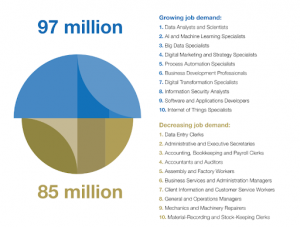As early as 2017, a McKinsey report claimed that with the world becoming increasingly technology-driven, automation would force 375 million workers to seek skill upgrades or risk losing their jobs by 2030. However, the same report also suggested 300 to 365 million new jobs could be created by then, with about 8%-9% already in existence today.
What does this mean for the students who are preparing themselves for a successful career in the future? The oldest Gen Zers have already begun their journey in the job market. This is the time for professional associations to reconsider their career development initiatives.
The Changing Global Job Market
The job market is bound to undergo seismic shifts as AI and machine learning make repetitive manual tasks redundant. As a result, we have seen a change in focus in the corporate world from seeking hardcore technical skills to valuing soft skills. This trend is only expected to strengthen, with the most sought-after skills including cognitive flexibility, socio-emotional intelligence, critical thinking, creativity and innovation, and problem-solving.
Therefore, the responsibility of course developers and educators now is to prepare students to navigate a very different job market from what their predecessors have experienced.
Image Source: World Economic Forum
Nurturing Tomorrow’s Workforce
The new hybrid, if not wholly remote, shift in learning has made it easier to provide learner-centric solutions for enterprise-level capacity building. Some of the critical areas that need to be focused on to guide students toward a future career path are:
Personalized Learning Solutions
When powerful analytics and custom reporting tools are used, learning can be personalized to address each student’s strengths and areas of improvement. Individualized learning paths can also be recommended based on targeted skills. Adaptive learning platforms simplify this process while allowing self-directed learning, which has proven to bring better academic outcomes.
Learning at a convenient time and pace is the focus when selecting a learning platform or a course. Personalized learning solutions to help students:
- Identify their strengths and weaknesses
- Hone career-specific skills
- Recognize the right career or career path
- Transition to a profession that suits their aptitude and matches their career expectations.
Education with a Vision
The workforce of the future is in school, waiting to be introduced to the plethora of opportunities the future holds for them. As a result, career guidance has become an integral part of pedagogy. EdTech-based solutions can support such advice by deeply analyzing student learning patterns, speed, accuracy, and interests.
Online course platforms can help associations address learner needs from the early stages of career development. For example, technology can be leveraged to map careers to skills with ease. In addition, they can help engage young learners and inform them of specific career opportunities through innovative ways, such as:
- Interactive Videos: Create career path catalogs with imagery, videos, documentaries, and dialogues from experts in different fields.
- Leverage AR/VR: Provide 360-degree virtual tours for a realistic feel of what a specific career entails. For instance, a virtual tour of art galleries and museums can help students understand the professional dynamics of being a curator.
- Enable Learning by Doing: Make virtual labs available for students to experience “a day in the life of …” different professionals. For instance, let them experience simulations of nursing, management of a specific industry, etc.
- Improved Assessment Models: Administer assessments based on personal interests to judge future learning direction and help students explore and navigate suitable career paths.
- Collaborative Tools: Promote soft skills and social-emotional learning even in online courses through collaboration on assignments, real-world problem-solving, and more.
Globalization of the Workforce
Professional associations have a tremendous opportunity and an equally significant responsibility due to the sheer expansion of their customer base. Providing tools for educators and learners to prepare the students for the future job market can help capture the opportunity and fulfill the responsibility.
Focus on Skill-Based Career Guidance
Embed career guidance with learning modules based on skill rather than geographies or demographics. Use digitization to your advantage to prepare students for future jobs that are likely to be technology-driven.
Support Mobility
Tailor your materials to be responsive to different screen sizes while allowing offline access anytime, anywhere learning. A cloud-based online course platform can ensure optimal performance, regardless of the region from where the student is accessing the course.
Ensure Easy Interoperability
Offer different functionalities and features based on user roles and subscription models, with multi-tenant architecture on a single personalized learning solutions platform. Integrating seamlessly with existing ecosystems promotes adoption rates for online course platforms. Also, maintain compliance with international regulations and standards to provide genuinely globalized education.
Wrapping Up
A personalized learning solution will be quickly adopted only when all stakeholders, professional associations, students, parents, and educators agree. With a flexible and customizable platform, you can nurture young learners and provide the information they need to steer their career paths. You can also pique learner interest in specific careers supported by your association.
Choosing the correct digital content creation and distribution platform that easily integrates with the educational institution’s existing ecosystem can also help you win partnerships with schools and colleges to promote your career streams. Plus, end-to-end marketing programs can be eased with a platform that equally supports parents, students, admin, and teachers.
Want to learn which adaptive learning platform can power your association to nurture the workforce of tomorrow? Talk to us TODAY.
















